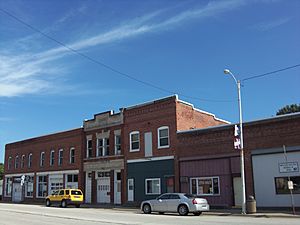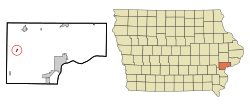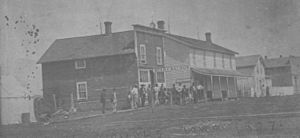Nichols, Iowa facts for kids
Quick facts for kids
Nichols, Iowa
|
|
|---|---|
 |
|

Location of Nichols, Iowa
|
|
| Country | |
| State | |
| County | Muscatine |
| Area | |
| • Total | 0.23 sq mi (0.59 km2) |
| • Land | 0.23 sq mi (0.59 km2) |
| • Water | 0.00 sq mi (0.00 km2) |
| Elevation | 633 ft (193 m) |
| Population
(2020)
|
|
| • Total | 340 |
| • Density | 1,491.23/sq mi (576.25/km2) |
| Time zone | UTC-6 (Central (CST)) |
| • Summer (DST) | UTC-5 (CDT) |
| ZIP code |
52766
|
| Area code(s) | 319 |
| FIPS code | 19-56685 |
| GNIS feature ID | 0459517 |
Nichols is a small city in Muscatine County, Iowa, USA. In 2020, about 340 people lived there. It is part of the Muscatine area.
Contents
What's in a Name? The Story of Nichols
The area where Nichols now stands was first called Railroad Addition. Later, people started calling it Nichols Station. This was because of Benjamin F. Nichols.
Benjamin F. Nichols named the town after his father, Samuel Nichols. Samuel was very important in bringing the railroad to this area. He invested a lot of money in the Burlington, Cedar Rapids and Northern Railroad Company. He also owned a lot of land. Samuel Nichols allowed the railroad to build tracks across his land. He also helped them set up a train station right where Nichols is today.
A Look Back: The History of Nichols
Nichols started in the early 1870s. It was built in an area known as Elephant Swamp. The town was planned as a place for trains to stop. Farmers could ship their crops and furs to faraway markets from here.
The land for the town was given by Samuel and Benjamin Nichols. They wanted a train station built there. George Bumgardner, a county surveyor, measured the land for the town in June 1871.
Railroads and Early Buildings
Two train lines eventually ran through Nichols. These were the Muscatine & Western Railroad and the Burlington, Cedar Rapids and Northern Railroad. Both of these were part of the larger Rock Island system. The first train line and station were built in the early 1870s.
Dr. S. H. Smith built the very first building in Nichols in 1871. He used it as both a drug store and his home. The Muscatine & Western Railroad reached the site in 1873. The railroad company then added more land to the town, calling it Railroad Addition.
At first, many buildings and homes were log cabins. Later, they were replaced with stronger brick buildings.
Community Growth and Services
Benjamin Nichols opened the first post office in 1870. He was also the first postmaster. The first school was built in 1872, so children could learn.
Churches also became an important part of the community. A Christian church was started in the winter of 1873-1874. Services were held in schoolhouses until their church was built in 1874. The German Evangelical Protestant Church began in 1874. The Catholic church, called Church of St. Mary, was built in 1874. A Methodist church was organized in 1875.
The town quickly grew. It soon had several banks, an opera house for entertainment, and a town hall built in 1897.
Economy and Trade
The early economy of Nichols was all about the two train lines. People also bought and shipped furs. Farming was very important too. Large grain elevators, run by Foley and Brugman Brothers, could hold 15,000 bushels of grain each. Farmers also shipped cattle and hogs by train to sell them in other places.
On September 18, 2020, the main business area of Nichols was added to the National Register of Historic Places. This means it is a special place with historical importance. It is now known as the Ijem Avenue Commercial Historic District.
Where is Nichols? Geography and Surroundings
Nichols is located at 41°28′45″N 91°18′30″W / 41.47917°N 91.30833°W. It is in the western part of Iowa's Muscatine County. The land around Nichols is a mix of grassy prairies and rich, low-lying areas.
Jordan Creek flows just southeast of the city. This creek then flows into Wapsinonoc Creek. Wapsinonoc Creek is a smaller stream that eventually joins the Cedar River.
The United States Census Bureau says that Nichols covers about 0.23 square miles (0.59 square kilometers). All of this area is land.
How Many People Live Here? Demographics
Nichols is a small community. In 2020, the city had 340 residents. There were 143 households, which means 143 different homes where people lived.
- About 86.8% of the people were White.
- About 1.8% were Black or African American.
- About 1.5% were Asian.
- About 11.2% of the population were Hispanic or Latino.
The average age of people in Nichols was 46.3 years old.
- About 22.6% of residents were under 20 years old.
- About 18.8% were 65 years old or older.
- The city had slightly more males (52.1%) than females (47.9%).
Learning in Nichols: Education
The West Liberty Community School District is in charge of the public schools in Nichols. This district makes sure that students in the area get their education.
Images for kids
See also
 In Spanish: Nichols (Iowa) para niños
In Spanish: Nichols (Iowa) para niños



